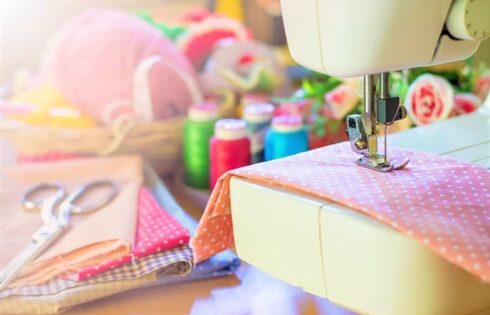Learn How to Sew Anything That Needs Sewing
If you have never held a needle and thread or threaded a sewing machine, the idea of learning how to sew anything, can seem over whelming. It doesn’t have to be. The first step is to allow yourself a little bit of time to find the basic information you need, then take a deep breath, relax and then start enjoying how much sewing increases your sense of accomplishment and creativity, to say nothing of the amount of money you will save by knowing how to sew your own mending, repairs and sew things from scratch. No one knows everything when they start a new project, so allow yourself to learn sewing one step at a time and develop your sewing skills as you go. The idea is to enjoy your new hobby and develop skills at your own pace while accomplishing something in the process.
Sewing Terms and Vocabulary
Vocabulary can be one of the biggest barriers to learning any new skill and learning how to sew is no different. A sewing glossary is a great thing to book mark so you can refer to it anytime you run across a word or a term you don’t understand while you learn how to sew.

No-Sew Sewing – Fusible Options
Did you know you can “sew” fabric and other textiles, without ever threading a needle or even having a needle and thread on hand. No sew sewing is achieved with the fusibles that will join two pieces of textiles with a fusible material that requires heat to “glue” the two pieces together. Fusibles are a way to mend tears that are bound to show no mater what type of stitching you try to use. Fusibles are a great way to hem a garment without having any stitching showing and to have a hemmed garment in a hurry.
Hand Sewing
Fusibles are one solution to never threading a needle but I’m not sure I’d trust an entire garment that was constructed with fusibles. Eventually you will want to sew and be creative, which will lead to you learning about needles and thread. Hand sewing is one options that is an economical choice to get started. Time and patience can sew an entire garment or item by hand.
Mending and Repairs
Everyone should learn to sew even if your sewing skills never surpass learning to do simple mending projects. No one wants to buy a whole new shirt just because a button came off the shirt. Perhaps the thread broke in a seam. Any way you look at it a simple mending job is much less expensive than shopping for and buying a whole new item.
Sewing Box and Sewing Tools
Any job, not just sewing, is easier if you have the correct tool for the job. Gaining a good supply of sewing tools doesn’t have to break the bank. A pair of scissors from a dollar store can go a long way to get you started if you never cut a piece of papers with those scissors. There are many ways to save money by sewing and those tips and tricks can be applied to accumulating a wonderful sewing box full of the best sewing equipment available.
Fabric and Interfacing
It is rare for someone to realize just how much fabric surrounds them and effects their daily life. Most people think about the clothes that cover their body, the sheets and blankets on their bed and the linens in their bathroom. You sit on a chair or sofa and don’t stop to think about the fabric that is sewn together to make that furniture comfortable. Window covering are usually thought of as curtains or drapes, but the fabric that makes them up, is rarely thought about on it’s own merit.
Clothing and other fabric items, have un-seen elements that lend stiffness or support to the main item. Facings usually have a form of interfacing to hold the faced area in place and add body to the area. Comforters and other insulated items, usually have a form of batting inside to provide the insulating value. Lining is an important part of many garments but rarely do people think about the lining fabric and how it got in place.
Fabric has different qualities that need to be taken into consideration when you go to lay out a pattern. If you’ve ever had a pair of pants, that the leg wanted to wrap around your leg, you have experienced an item that was not cut out on the straight grain of the fabric. Learning about fabric qualities will help you make educated choices at the fabric store and choices that are appropriate for the item you want to make.
Sewing Machines
Eventually most people graduate to wanting their own sewing machine. Almost everyone has a sewing machine that has been passed down through generations and probably hasn’t been used for a couple of generations… or they have a sewing machine that was found at a yard sale or thrift store. Whatever the story behind your sewing machine, you need to have the manual to your sewing machine. That manual will help you solve problems when they surface and prevent hours or frustration.